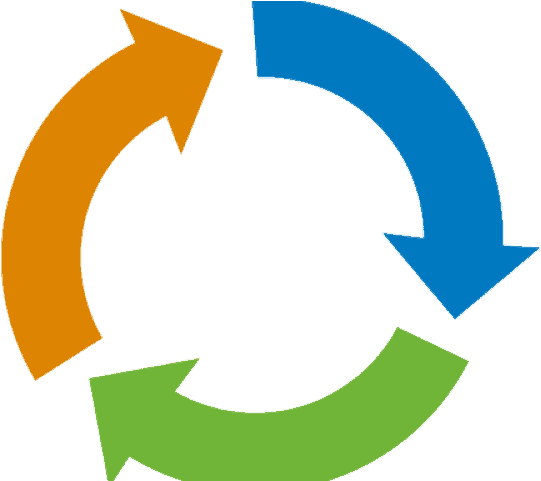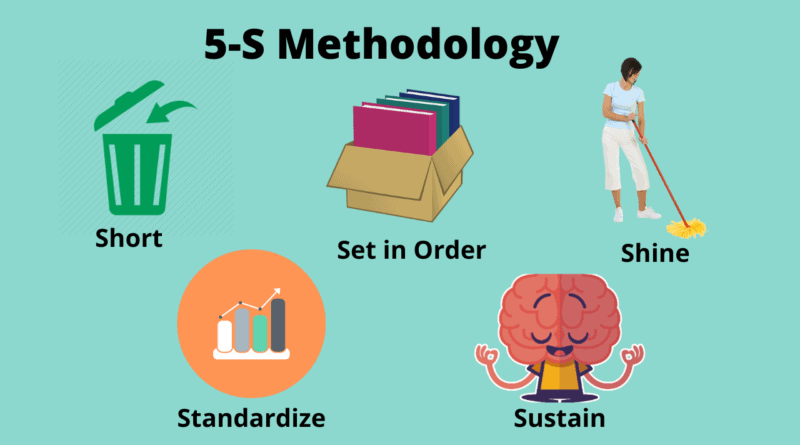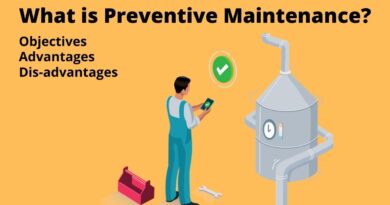What is 5S methodology? History, benefits,PDF
5-S is a system for organizing spaces so work can be performed efficiently and safely. This system concentrates on putting everything where it belongs and keeping the workplace clean, which makes it easier for people to do their jobs without wasting time or risking injury.
The 5-s methodology uses a list of 5 Japanese words;
- Seiri
- Seiton
- Seiso
- Seiketsu
- Shitsuke
These have been translated as;
- Sort
- Set in Order
- Shine
- Standardize
- Sustain
Each word of the 5-S method starts with an S, and Each S represents one part of a five-step process that can enhance the overall function of a business.
let’s discuss each word of the 5S methodology separately.
What you are going to learn?
5-s methodology
1. Seiri (Sort)
Which means sort. This activity involves going through all the contents of a workspace to determine which is needed and which can be removed. This way material management team keeps only the essential things needed to complete tasks.
Goals of sort are-
- Reduce the chance of distraction in the workplace by unnecessary items.
- Simplify inspection process.
- Increase the amount of available, useful space within the workspace.
- Increase safety by eliminating obstacles during the operation.

For this step, inspect the items, tools, and materials in a work area. We should keep there items that are necessary or useful for the work being done in that space. Everything else can be removed.
If you find an item that you can’t identify, or that has unclear ownership, it’s time to use a red tag. “Red-Tagging” temporarily attaches a highly-visible tag to the item, which mentions where it was found and when it was found. Then, red-tagged items from all work areas are collected in a single location: a “lost and found” for tools, materials, and equipment.
Items may stay in the red tag collection area for a long time. In one typical approach, items can be left in the red tag collection space for thirty days. After that, any supervisor may claim the item for their own work area. If nobody wants it after another week, the item can be removed from the facility entirely. They can sell it, recycle it, or throw it away.
2. Seiton (Set in Order)
Which means Set in Order. This activity assures that all items are organized, and each item has a designated place. Organize all the components left in the workplace logically, so they make tasks easier for workers to finish. This usually involves placing items in ergonomic locations where people will not need to twist or make extra movements to reach them.
The aim of seiton (Set in Order) is to make the workflow smooth.

We should store tools that are used frequently near the place they are used. Spare equipment, supplies, and other tools that are used less usually can be kept in a central location, where multiple teams can share them.
A 5S map is a diagram or floor plan that summarizes a work area, process, or station. It presents a visual reference to show where the tools, supplies, workers, and travel paths are, and how they relate to each other. A good map may also describe the work that happens in the area shown.
Depending on your facility’s needs, you may find one method easier than another:
- Draw up a map, and then implement it.
- Physically arrange the workplace first, and then map it out.
- Map as you go, testing ideas and writing down what works well.
Many facilities use a “shadow board” for tool storage, to assure that each tool is easy to put back in its correct storage place. With this method, we placed a label matching the shape and size of the tool where that tool belongs. Workers can immediately find where each item belongs, and know at a glance if the tool is there or not.
3. Seiso (Shine)
Which means Shine. It is a proactive effort to keep work areas clean and orderly to ensure purpose-driven work. This means cleaning and maintaining the freshly organized workspace. This process concerns routine tasks such as mopping, dusting or performing maintenance.
Objectives of seiso (Shine) are:
- To improve the production process efficiency and safety, reduce waste, prevent errors and defects.
- Keep the workplace clean and pleasing to work in.

Everybody should pay attention to the overall cleanliness of the workplace, being willing to pick up trash and so on. But for 5S to give the best results, each employee should take personal responsibility for their own working area.
One important advantage of Seiso (Shine) is that it’s easy to spot leaks, cracks, or misalignments, etc. If the workers keeping the area clean are the same worker who work there regularly, they will be quick to notice any of these problems. Leaving those problems unnoticed and unresolved could cause equipment failure, safety hazards, and loss of productivity.
4. Seiketsu (Standardize)
Which means Standardize. Seiketsu is to standardize the processes used to create a set of standards for both organization and processes. This is where you take the first three S’s and make rules for how and when these tasks will be performed.
These standards can involve schedules, charts, etc.
The aim of seiketsu (Standardize) is to establish procedures and schedules to ensure the repetition of the first three ‘S’ practices.

“If it isn’t written down, it didn’t happen.” Writing the decisions that you make in your 5S program will help ensure that your work doesn’t just disappear. If you made a 5S map in the Set In Order step, that map can be part of your recent standard for the area.
After you’ve made your decisions on how to change your work practices, those decisions need to be communicated to employees. Common tools for this process include:
- 5S checklists– Listing each steps of a process makes it easy for employees to follow that process completely.
- Job cycle charts – Identify each task to be performed in a specific work area, and decide on a schedule or frequency for each of those tasks. Then, distribute responsibility to a particular employee. It can post visibly the resulting chart to resolve questions and promote accountability.
- Procedure labels and signs– Provide operating instructions, cleaning steps, and preventative maintenance procedures right where that information will be needed.
5. Shitsuke (Sustain)
Which means sustain. Sustain means the previous four S’s must be continued over time. They achieved this by developing a sense of self-discipline in employees who will take part in 5S.
The aim of sustain is to organize training and perform regular audits to ensure that the 5S approach is followed.

Sustaining a 5S program can mean different things in specific workplaces, but there are some elements that are common in successful 5S programs.
They are:
Management support – Without a visible commitment from managers, the 5S processes won’t stick around. It should involve supervisors and managers in auditing the 5S work processes and getting feedback from employees.
Department tours – Moving teams from one department to visit other departments will help familiarize the entire workforce with the processes of your facility. This type of “cross pollination” helps to develop good ideas and motivates employees to come up with new ways to improve the 5S implementation.
Updated training – As time goes, there may be changes in your workplace, such as new equipment, new products, or updated work rules. When this happens, you need to review your 5S work standards to accommodate those changes, and provide training on the new standards.
Progress audits – The standards that are set up in the 5S program should provide specific and quantitative goals. Checking on those goals with a periodic audit can provide important information and guidance.
Performance evaluations – Once you know your goals are legitimate, make performance part of each employee evaluation. Whenever teams and individuals perform well, celebrate it, and place overall results on a wall so each team can see how they compare to the rest of the facility.
Safety – The 6th S
Some enterprises like to introduce a sixth S in their 5S program: Safety. Unlike the first five steps, safety is not a sequential step. We must consider it during each of the other steps. Keeping workers safe isn’t just the right thing to do: there is a substantial monetary cost for accidental workplace injuries.

For example, during the Sort phase, you may have decided that a tool is obsolete because a newer version is safer to work. Similarly, during the Standardize step, work methods need to be standardized to improve workplace safety, not just increase efficiency.
Some people look at safety as an outcome of performing the other five S’s appropriately, and as a result, say a sixth S isn’t necessary. They think if the workplace is perfectly organized and cleaned and uses helpful visual safety clues, a separate safety step is unnecessary.
Neither attitude toward safety is right or wrong. But a business that wants to approach safety should know paying attention to safety is important.
5s methodology history
The 5S method finds its lineage to post-world war in Japan, where the leaders of a prospering Toyota Industries were trying to reduce manufacturing waste and inefficiencies. Their solution, dubbed the Toyota Production System, comprises several methodologies that would become famous in their own right, including Just-In-Time manufacturing, Jidoka, and the core concept of the visual workplace.
Initially, the Toyota Production System was a closely guarded secret, but a tremendous economic boom Japan has experienced in the 1980s attracted extreme interest from foreign corporations wondering how Toyota, the shiniest jewel in Japan’s manufacturing crown, could build so many products, so rapidly, at such a high-quality level. Gradually, international exchange of ideas took shape, author and ULVAC Inc. executive Hiroyuki Hirano devised the five pillars of the visual workplace, a concept that would transmute into the 5S methodology as we know it today.
Benefits of 5S Program
There are so many benefits to implementing the 5S Methods into a workspace on the production line or in the business office. To not only survive but thrive in business today, the cost must be controlled and waste must be avoided or eliminated. Some benefits of implementing 5S methodology are:
Better usage of time – Getting rid of unwanted materials and organizing the tools and supplies will eliminate clutter and distraction. Workers find less and retrieving what they need, and can be more productive instead.
Proper utilization of space – Eliminating unnecessary material accumulations and merging tool storage will clear up room for more convenient applications. Every square foot of floor space has a cost, and getting the maximum out of that investment will expand your profitability.
Reduced chance of injury – Organizing the work areas for achieving better efficiency and ease of use will reduce the worker movements needed to do their jobs. Eliminating clutter and routinely cleaning up spills will remove slip possibilities. As a result, workers will experience less fatigue and fewer injuries will take place.
Reduced downtime – When you keep tools and equipment clean, routinely inspected, and used in a standardized way, preventative maintenance has become much easier, and you can often prevent entirely major failures.
Improved consistency and quality – Standardizing work processes will reduce deviations and mistakes. By eliminating faults and failures, overall productivity can be dramatically improved.
Raised employee morale – When 5S principles are implemented effectively, workers see that their input is valued, and their performance is recognized in the organization. This creates an environment where workers can feel the pride to work, and take an interest in improving their firm.
Who Should Participate in 5S?
The quick answer to this question is: everyone can take part. If a department is participating in 5S, managers and all other employees should be included. If they leave anyone out, this could lead to confusion or to mess that people don’t want to take ownership of.
Definitely, some people will play a bigger role in 5S than others, which is fine. There might be 5S coordinators who are to instal and maintaining 5S labelling, keeping records of assigned tasks, or bringing in new department members to the 5S system. These people will obviously put in a lot of time thinking about 5S compared to others. Everyone should think about 5S regularly, though. 5S might originally take place as an event, but ideally, it turns into a part of daily work for everybody.
5S Training
Anyone who will take part in 5S should be get training. It could be done in a classroom setting, with training videos, or through practical hands-on activities. A demonstration of how 5S could take place at a workstation might be helpful.
For employees to understand why the company is going to use 5S and why it’s necessary, they should be given a a concise history of 5S, its parts, and its benefits.
It’s quite possible that the way they carried 5S out at one organization or even one department will differ from others, so groups performing 5S for the first time may need to work out the best way to perform the steps of 5S in their spaces.
Everyone employee should undergo training when 5S is new, and then any fresh employees who come on board later should receive training about 5S as well.





Pingback: What is Lean Manufacturing? 5 Principles, 8 waste, PDF - EDUCATIONLEAVES